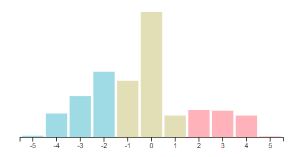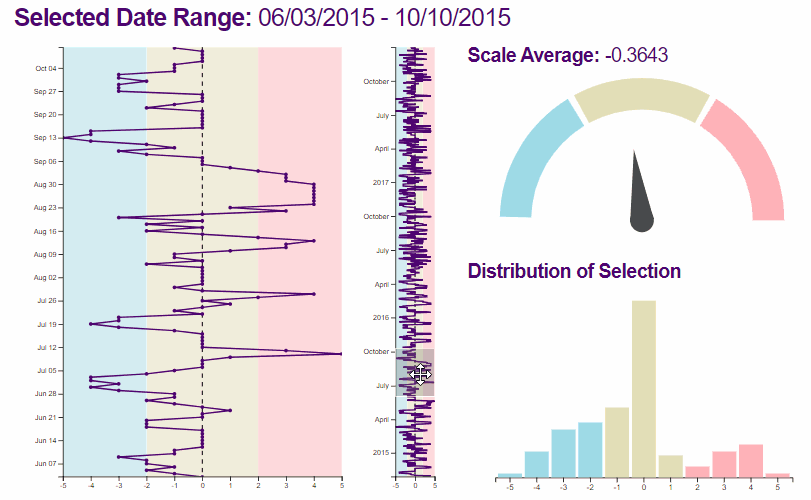
Plot Me Genderfluid
Quantifying my Queer Self using 3 Years of Gender Data

What the What?!
Let’s kick things off with a 101 – What is genderfluid / gender-fluid / gender fluid?
Good news! It's not too much of a mystery anymore, in September 2016 we made the dictionary!
MERRIAM WEBSTER DICTIONARY DEFINITION

So genderfluidity is characterized by moving between genders, or with a fluctuating gender identity!
This is also a good time to mention that gender is a social construct (so is sex if we really want to get into it), there are more than 2 genders (infinite in fact), and that genderfluidity falls under the non-binary umbrella, which in turn falls under the trans umbrella.
Simplified Illustration of Gender Umbrella Terms
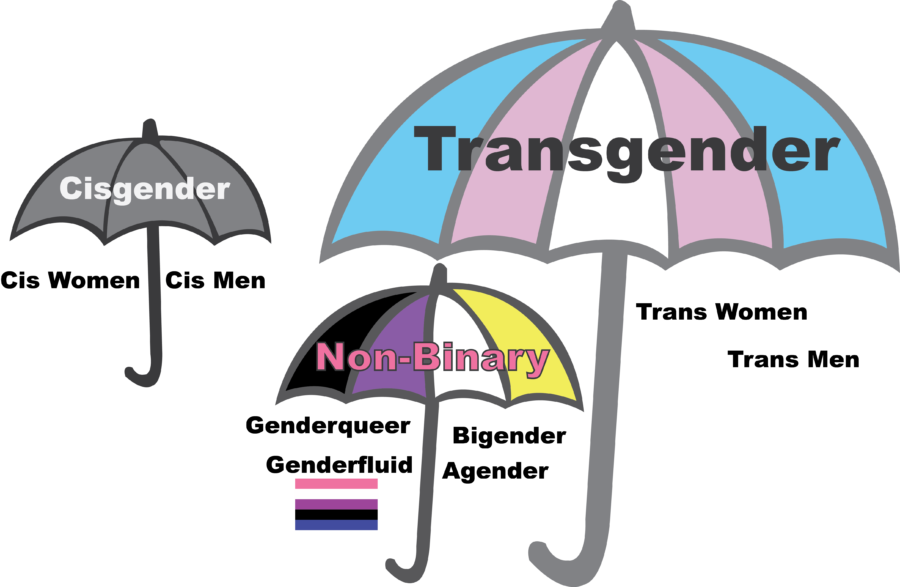
Is this completely foreign? No problem, it can be confusing when your understanding of gender is expanded beyond the typical “Man” / “Woman” (no, seriously, that is pretty much what this entire piece is about!). Here is a short list of trans 101 – type resources:
- PFLAG has a pretty nice glossary of LGBTQ+ terms
- So does The Trevor Project
- A pretty good summary of gender dimensions
- “The Gender Unicorn” is a constantly improving educational tool for breaking down gender identity vs sex assigned at birth vs expression and more!


My Journey
TW: Internalized Transphobia (but it turns out ok in the end!)
In hindsight, I have always been genderfluid – my personal experience being fluctuating between typical masculine, feminine, gender neutral, and agender identities. However, without knowing that the concept of genderfluidity was a thing until my mid 20’s, these fluctuations were the cause of much confusion growing up. Assigned female at birth (afab), as a kid I was described as “tomboy-ish”, often taking pride in rejecting stereotypically girly things. Alot of the time I felt like I was born in the “wrong body”. I have very clear memories of reading a Louis Sachar book in elementary school where the boy kisses his elbow and turns into a girl. It was supposed to speak to gender differences and social taboos or something – but that apparently didn’t resonate. I just remember spending hours trying to kiss my elbow so I could turn into a boy. I did not succeed.

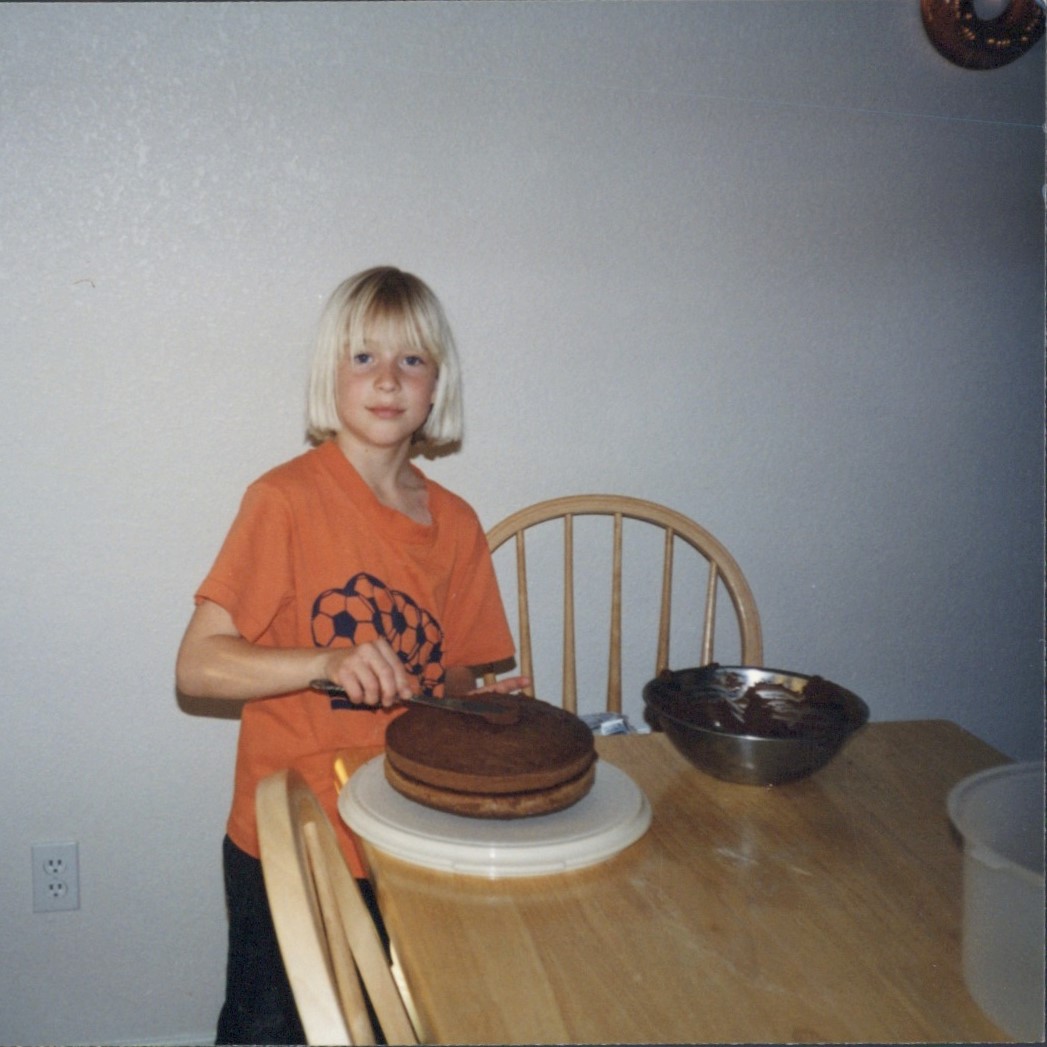
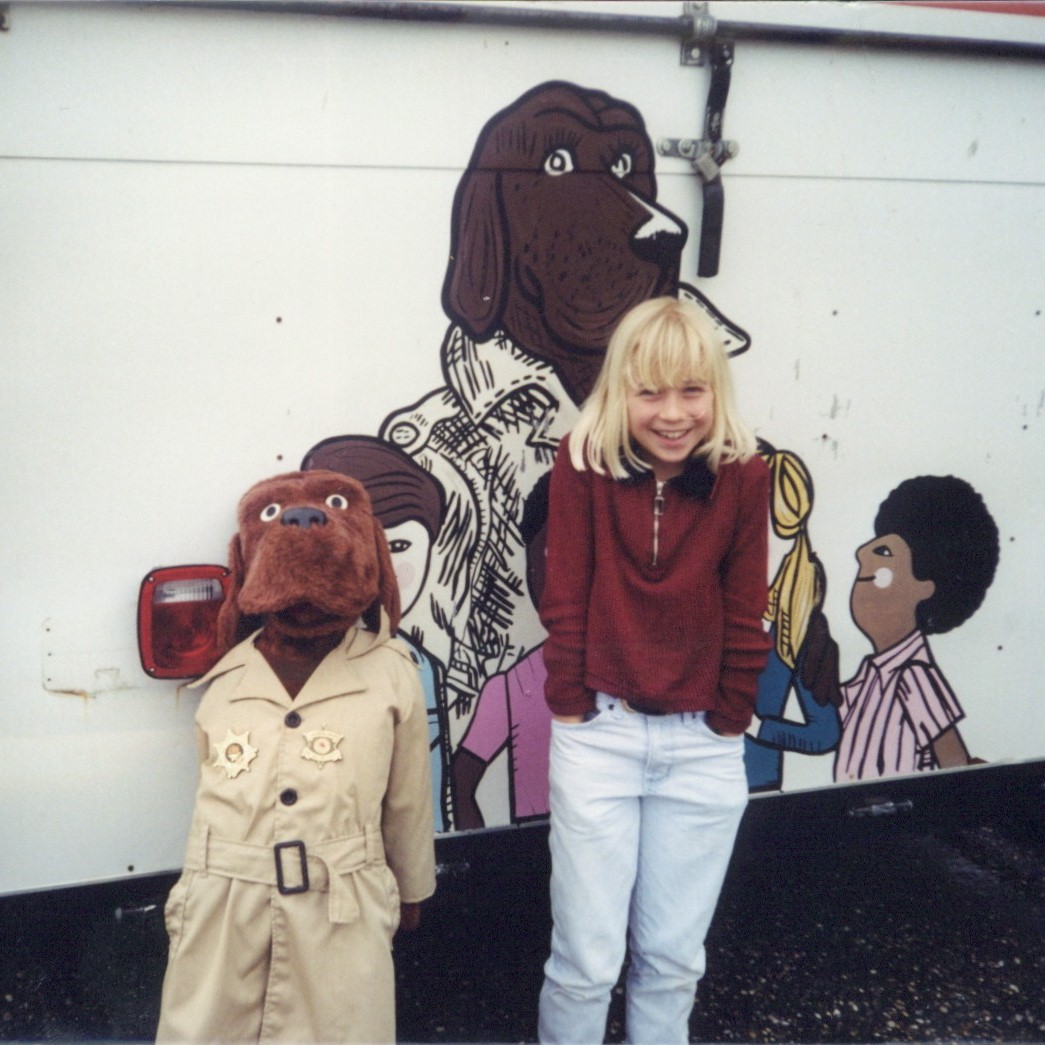
I femme’d it up a bit around puberty, cause expectations. In high school I met my partner and realized I wasn’t straight. Looking back I think my gender identity complicated and delayed that realization a bit – I would confuse looking at boys in an envious way as sexual attraction. In college, I started questioning my gender identity more. There were many aspects of my current and childhood experiences that fell in line with a typical FTM (female-to-male) narrative. Since I didn’t know anything outside the gender binary, if I didn’t and had never felt fully female, I must be male! Early college I explored this, I dressed pretty masculine, and actually “passed” often in social settings. I remember my mom on the phone once being all mom-ish like “You don’t walk alone at night do you? It’s not safe for young women to walk alone at night!” and just laughing in my head because of how rarely I got clocked as female by strangers. I was that confident!



I considered transitioning during this time, but the unstable nature of my unknown genderfluidity could not be ignored. No matter how much I was trying to fit into this typical trans narrative, occasionally I would have periods where I felt genuinely and intensely feminine! How could I transition if this happened? By about my sophomore year I was tired of struggling and being confused. I told myself that obviously I didn’t “feel it strongly enough” to start hormones or do any sort of physical or social transition. So if I wasn’t going to do anything about it I was just going to have to be happy being female. I started presenting more feminine (still in my “tomboy-ish” or gender neutral way) and stifled any remaining trans questions.
Notable though was that in 2009 (probably my Junior year) Dr. Kand McQueen came to my school and gave a presentation on gender identity and the gender dichotomy. It was such an enlightenment for me, I had literally no concept of gender beyond the binary before this time! This was the first exposure I had to the transgender umbrella, non-binary identities, and the concept of genderqueer or gender-neutrality. I was more just amazed at the concept in general, but I guess I did look internally a bit, thinking maybe I fell somewhere on the genderqueer spectrum - but still not allowing myself to really fret about gender again since “I wasn’t going to do anything about it”.
 Fast forward to February 2014, I was 24, a friend’s partner was desperate to find some LGBT folks to fill out a panel for a university class she taught - I was a willing gay. During the panel something amazing happened. One of the other panel members explained that he currently identified as a homosexual man, but since gender and sexuality was fluid, this might change in the future. My mind was blown, I had never considered before that moment that these things could change! I had always imagined them as fixed and it just took you time to realize what you were.
Fast forward to February 2014, I was 24, a friend’s partner was desperate to find some LGBT folks to fill out a panel for a university class she taught - I was a willing gay. During the panel something amazing happened. One of the other panel members explained that he currently identified as a homosexual man, but since gender and sexuality was fluid, this might change in the future. My mind was blown, I had never considered before that moment that these things could change! I had always imagined them as fixed and it just took you time to realize what you were.
I didn’t connect the dots right away though – it was presented as gender/sexual orientation can shift over time, not the daily or even more frequent fluctuations I experienced. But, as luck would have it, this was right around the time that Facebook introduced their expanded gender options. I was browsing an article about it when the genderfluid definition caught my eye (likely because of the panel comments from earlier).

I remember reading the definition and just feeling the most intense sense of relief. This was it! After years of feeling broken and weird and alone, my experience had a name, there were presumably others out there like me! I probably cried. It was ironic how someone who was known to be very “ugh, labels are so stifling” found so much freedom in this one. I told my partner - literally the most open-minded person I know and who had been supportively by my side since I was 16 – immediately, and we jumped up and down excited.

Daily Tracking
While it was freeing to finally find the “label” that described my experience, this was really just the beginning of another journey. My genderfluid realization came with its own basket of complications. While I considered myself to be an open-minded person and an advocate for other’s queer identities, for some reason I had a hard time fully accepting it when it was personal. Initially it turned into, “yea I’m genderfluid, but I’m going to force myself to be feminine because I need control”. As this inevitably started affecting my life negatively, I was urged by a therapist to start tracking my gender fluctuations so that I could understand them better. It was good advice, and because I am a data nerd, I ended up taking it to a whole other level.
I started a spreadsheet and logged my gender daily. I created a scale from -5 to 5 to document where I fell for the day. A value of -5 indicated a highly masculine day, whereas a value of 5 specified an extremely feminine day. A value of 0 represented a purely neutral day, either in the agender (without gender) or genderqueer (mix of masculine/feminine) sense. I know the gender spectrum concept isn’t completely accurate, but it was helpful in representing things for me. I also kept track of the max and min of the gender scale for days that had multiple fluctuations, although to simplify the results shown here I only consider the overall daily gender value. In addition to the gender scale measures, I kept a free text column to write my thoughts or feelings about the day. I logged this information daily for over 3 years, from November 2014 to December 2017.
View of My data
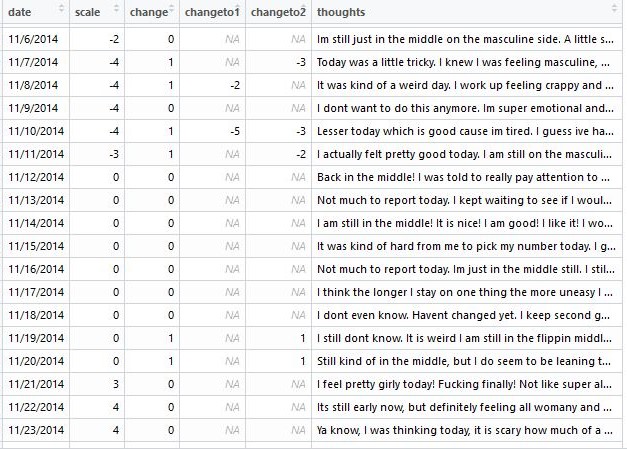
This setup of my data was specific to my experience of genderfluidity. I knew I fluctuated between our society’s typical definitions of masculinity, femininity, gender neutrality and occasionally agender. Others who identify as genderfluid might have a drastically different experience.
How do I define these things, in particular masculinity and femininity? That is indeed the question and I found as I worked through things my definitions also drastically changed. Initially, although I didn’t see it at the time, I had a very shallow understanding of gender - rooted in stereotypes, tropes, and other shitty things that are beaten into us when we live in this aggressively gendered society. In terms of the daily ranking I kept for my data though, I just “know” what gender I am if I check in with myself. It’s usually pretty clear, in the same way I imagine a cis woman “knows” they are a women.
For the purpose of visualization, I binned my gender scale into 3 categories (even though it kind of takes away from the spirit of genderfluidity and the gender spectrum) - it helps with understanding. Rankings from -5 to -3 are categorized as a "masculine" day, -2 to 2 as a "neutral" day, and 3 to 5 as a "feminine" day. Also before I get flak for using gendered colors (pink/blue) in the visualizations – know that they are used ironically and to help with clarity (since I know y’all just look at the pictures and don’t actually read my beautiful commentary). Trust me I know it is BS - anyone who has spent more than 20 minutes with me has likely gotten an earful of my thoughts about societies aggressive gendering of things that have no gender!
Data for Personal Discovery
Collecting and analyzing this data was a way for me to understand and quantify my experience. At the beginning of the exercise, I was struggling most with lack of control/predictability. Gender swings would come out of nowhere and would completely blindside me. So many emotions would come with a gender fluctuation since gender affected so many aspects of my life (we live in a highly gendered society if you didn’t know!). Most switches would come with changes to my mood, present-ness/engagement, comfort levels, social confidence, etc. Also masculine periods would often come with gender dysphoria, a term used in trans circles to describe intense distress felt due to a mismatch between physical and/or social appearance and gender. There was also a lot of feeling alone, different, “broken”.
At the same time I knew that I needed to find a way to be ok with the uncertainty because my genderfluidity was likely here to stay. So I made a pact to not over - data science things. I would only do exploratory/explanatory analyses, there would be no trying to predict no matter how much I wanted to “7-day Forecast” my gender.
I also knew I was prone to overanalyzing (what?!? shocking!). In hindsight it is painfully clear that initially I was constantly searching for “reasons” to explain the shifts.
- Sometimes in search of control
- Sometimes to shame myself for buying into societies gender norms or stereotypes
- At the extremes to question my identities validity – instead maybe it could be explained away by some other factors (hormones, social circles, environment, etc)
But as time passed and I worked through things, the search for reasons started to wane. I now realize the most valuable “finding” in doing this was validating my identity to myself. I could never find consistent outside explanations for my shifts, this is honestly just me.

The Basics
Gender Over Time
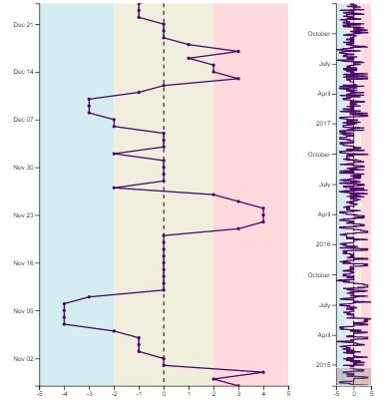
Because the main (or most apparent) struggle I was having initially was a lack of control or predictability, just plotting my gender over time was a huge eye-opener. Things were so overwhelming it felt as though my gender was constantly flip-floppin without warning, however, plotting it showed that my reality was much more stable than how it felt in the moment. I would almost always have a period of neutrality before switching from one extreme to the other.
Gender Distribution
Gender Overall
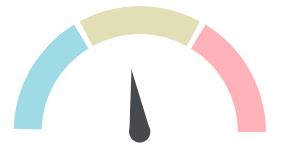
I also further rolled things up to see where I fell on the gender spectrum overall. This was just a straight average of all the days in my -5 to 5 ranged scale. For example, over 3 years of data found me falling just masculine of center, at -0.42.
I ended up fashioning these visualizations into a dashboard so that I could further explore my gender fluctuations during different time periods. Also I wanted to learn d3.js, so two birds with one stone!
Gender Tracker Dashboard
Navigated tour below, standalone dashboard tool available here if you’d like to explore.
Monthly Moves
A month might have 1-2 feminine and masculine periods, each lasting from a day or two to longer than a week. Between extremes, I typically spend significant time in the neutral zone.
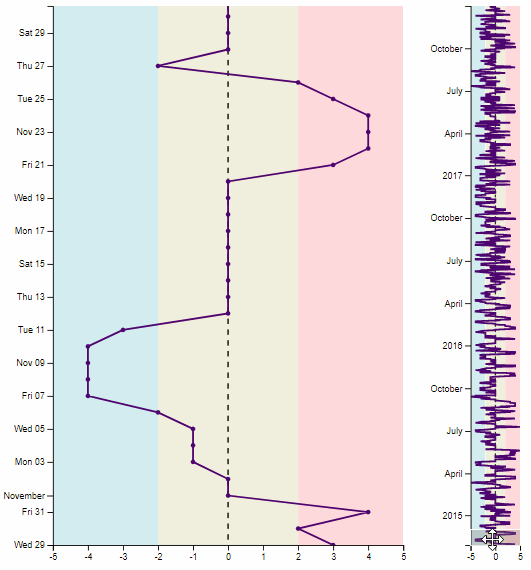
Early On
The first full year of tracking I clocked in at 51% Neutral days, 28% Masculine days, and 21% Feminine days. The chart shows that this translates to around 20 masculine swings and 14 feminine periods over the year.
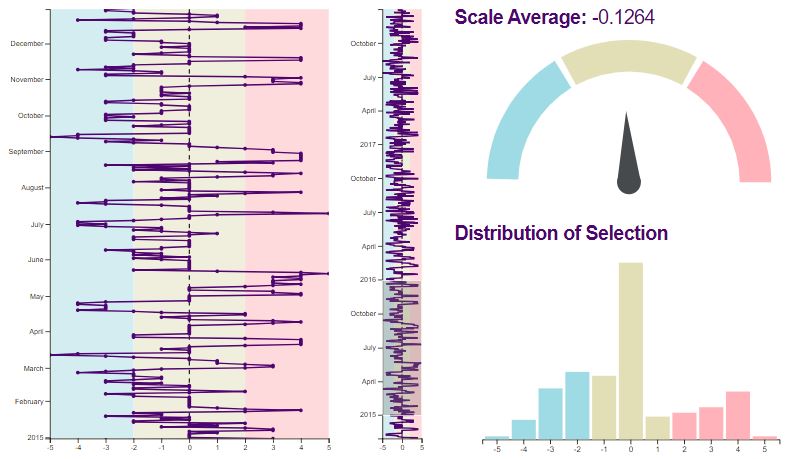
And Later
Two years later, the story changes a bit. I’m now spending 52% of days in the Neutral zone, 32% Masculine, and 15% Feminine. Overall this brings my average gender further blue to -0.57, however, still firm in the neutral zone. 2017 also realized an increase in the number of swings as well – going up to 27 masculine and 18 feminine periods during the year.
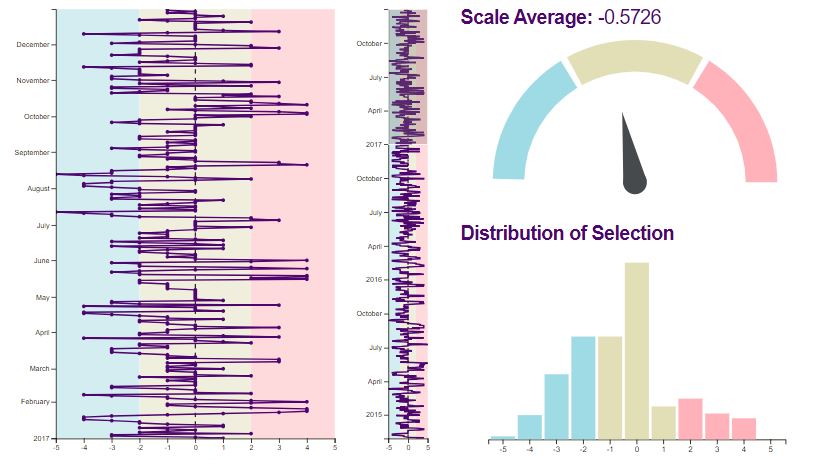
Post "Aha!"
Inspecting the overall timeline, seems that these 2017 changes maybe have actually started back in April of 2016. Visually the fluctuations appear tighter and more frequent compared to the prior time period. A couple things were happening at this point in time. First, a major life change as I was finishing my master’s degree and moving to a new state to start a new job. Second, a pretty major shift in my thinking happened mid-month – an “aha! moment” for you Oprah fans. More on this later.
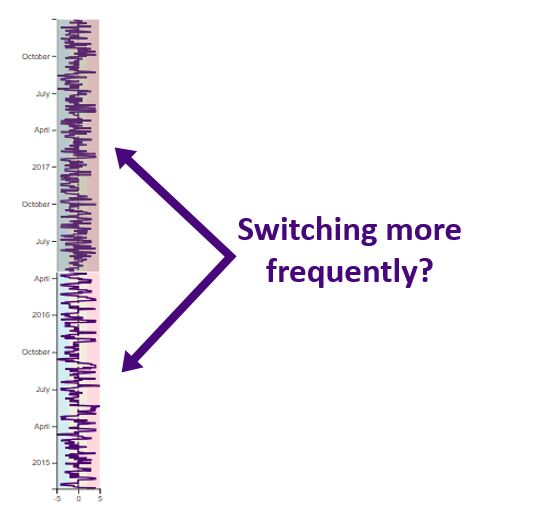
Knowing these basic metrics about my gender helped give me a sense of “what to expect” so things didn’t feel so out of control and unpredictable. Why are fluctuations such a big deal for me? Well, that is loaded question so buckle up. Things are about to get deep y’all. But c’mon you’ve already come this far!

Diving In - Words
So, I mentioned above how my gender affects a lot of different things – how I feel about myself, how present or “in my body” I feel, how comfortable I am in my body – which in turn sometimes affects what clothes I’m comfortable in, my sexuality, etc. How I dress or present will affect how people treat me, my sense of safety, how confident I am in social situations. This is not shocking information since gender is a core part of everyone’s identity, due to the fact that we live in a highly gendered society where gender dictates a ridiculous amount of things.
I could go on and on, but instead let’s take a look at some data!
Comparison Cloud of Feminine vs Masculine Words
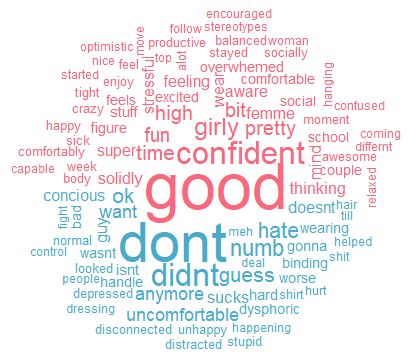
The comparison cloud compares the relative frequency with which a word was used on masculine compared to feminine days (neutral days are less extreme and just not very interesting so they are not included). The bigger the word is the more it was used in that category compared to the other. I know word clouds are pretty polarizing in the dataviz community, but it really represented the data well for an initial discussion. The word groups show a stark difference – with masculine day words having a much more negative vibe.
For context, here are some insight into the some of the words:
Feminine Words Explained
Confident/Comfortable/Good – Usually used in an “I feel comfortable in my body” way, or “Good day, felt confident”. Pretty self-explanatory there.
High/Aware – Especially at the beginning of this exercise I expressed a lot of awe/disbelief at how “aware of my body” I suddenly felt and the experience of feeling feminine as a complete “high”. It seemed like every time I would forget just *how good* it felt to actually feel whole, almost like a reawakening where I suddenly felt extremely alive and unstoppable. And because I like to overthink, this would usually be followed by some sadness at how I must have been unaware of how shitty I was feeling before, shame for how much I “allowed” gender to dictate my wellbeing, and anxiety about when the good feeling was going to end. All of this would usually be rounded out by some wonderings on “is this how cis people feel all the time??!!?” (well, is it?!?!).
Tight/Wear – These words would typically be used to describe the clothes I felt like wearing when feminine – I would be comfortable in tighter clothes (not my usual go-to) because finally I would not be disgusted by my curves. Words like “heels” and “dangly earrings” are also things that I enjoy while feminine, or things that make me feel more feminine, and they ranked pretty high in pure word counts, but I don’t think made the comparison cloud because I reference them a good bit while masculine. I don’t always usually dress for my gender, especially when masculine (for reasons discussed later), so if I found myself in something like heels (that I would typically associate with femininity) while masculine, I would typically have a lot to write about…
Girly/Pretty – In the same vein, on feminine days I would more often write about feeling or liking things I associated with being “girly” or “pretty”. These are definitely not things I, or anyone who knows me, normally use to describe me, so when I do feel this way it is quite noteworthy!
Social/Socially – I write a lot about “doing good socially” on feminine days, or “feeling social”. Social anxiety is definitely a thing for me, but the fact that it is notably less or even non-existent on days where I am feeling both more whole and “acceptable to society” definitely says things about my levels of social and physical dysphoria.
Stereotypes – So because of my extremely good (“high”) feelings when feminine, and my taste for things typically associated with western culture’s ideas of femininity, I would often be concerned about conforming to “stereotypes”. I would write about giving into things that I felt were “girly” or “frivolous”, but then shame myself for it because it felt “silly” and “conform-y”. In other words I can’t just let myself enjoy a good thing for what it is, I gotta pick it apart and question every aspect of it...
In reality though, I think gender stereotypes and gendering items/activities/qualities desperately needs to be questioned and dismantled in ourselves and our culture. I learned over time that I shouldn’t shame myself for liking stereotypically feminine things when I am feeling feminine. We are all allowed to enjoy what we enjoy, no matter how we identify, and no matter how society labels it.
Masculine Words Explained
On the masculine side, I recognize a lot of the words in the cloud as being part of common distress phrases I wrote ALOT:
“I don’t want to do/deal with this anymore”
“I hate this”
“I want to be normal”
“Why is this happening?”
Stupid/Handle – You’ve probably gathered I’m not innately the most self-compassionate, so the above phrases would typically be accompanied by a lovely dose of shame: “I should be able to handle this” or “I hate being so stupid and dramatic about this”. Helpful stuff.
Fight/Control – I would talk about trying to fight either the feelings that would come with masculine swings or the masculine swing itself. Control was/is very important to me especially at the beginning, and feeling the intense emotions on either end of the spectrum made me feel very much not in control.
Depressed/Unhappy/Dysphoric – Pretty self-explanatory, I feel like my masculine swings bring up the same feelings as many transgender narratives I’ve heard. When I am feeling strongly masculine, everything feels off, wrong. But since my experience is temporary, there is nothing I can do about it. Trans men can consider transitioning – taking hormones, having surgery, etc to make their bodies more in line with their gender and ease their dysphoria. There are some non-binary transition things I’ve thought about, but the fluid and temporary nature of my gender hasn’t made it worth the risks and unknowns yet. Therefore, when I have masculine swings and am feeling dysphoric, things seem especially hopeless, like I’m just stuck feeling shitty until it passes.
Numb/Distracted/Disconnected – Related to the depression and dysphoria, I often feel very disconnected (from my body, from my surroundings, from my social network), I just feel very not present. Sometimes distractions are necessary just to get by, if I can focus on work or something else I can sometimes forget about everything going on. Numb was used in a couple different ways; physically feeling numb - probably related to feeling disconnected, meaning that sometimes either my entire body or the parts I am the most dysphoric about can physically feel numb (like it’s not mine). There is also emotionally numb, just not being able feel things anymore cause it is too difficult.
[Self-]conscious/Uncomfortable – These words would usually be used in the context of social situations during masculine swings. Feeling self-conscious or uncomfortable in my clothes, about my voice, or in social interactions. I don’t think I can truly explain just how hard it is to navigate our gendered society when you don’t feel connected to the body you are in and the gender everyone reads you as.
As a sidenote, I’ve gotten and there is a lot of “advice” out there for genderfluid people to just “dress how you feel”, like that is some magical cure for dysphoria some of us feel. Not my experience at all, and this misperception feels like such a belittlement of the entire concept to me. It’s not about the clothes, it’s so much deeper than that. “Gender confirming” clothes often make my dysphoria worse – when your body already feels wrong, seeing it not fill out a men’s shirt or stretch at the hips of a men’s pair of jeans can be extra devastating. Often when I’m masculine, even if I might feel more comfortable in men’s clothes, the social burden of dressing that way is often just too much to handle on top of everything else. Dressing more feminine or gender neutral can be easier in order to just get through the day. I’m already putting on an act to hide how depressed and disconnected I feel (since mental health discussions are also not “socially acceptable”), playing dress up is just part of the performance.
Hair/Binding/Hurt – These words are more referring to my physical appearance and alterations. I usually keep my hair short, which helps with dysphoria. However if I had neglected haircuts or during periods where I was growing out my hair (to be more “socially acceptable” for an event) I would likely have much to say about it. Binding (“safely” with a binder, not wraps/tape) is also something that can help dysphoria around my chest. If you are unfamiliar though, binding fucking hurts. It’s tight and uncomfortable, you can’t breathe, it’s hot, people have literally cracked ribs. Kind of shows how desperate of a place someone is in if this option is better than the alternative.
I have conflicting feelings about binding. It does help me mentally, but I also see it as a kind of self-harm mechanism - which makes me feel like I should try and not do it. I also have noticed when I am masculine for an extended period of time I will drop weight (probably from depression) and pick more at my skin. It’s easier to hurt a body that doesn’t feel like yours, or you are just so numb to everything that even feeling pain is an upgrade.
*bonus* Sucks – I was more just surprised and amused to see this in here. I’ve made efforts to completely remove this word from my vocabulary in recent years as it is sexist/homophobic. But apparently I used to say it quite a lot to describe my indeed “bad” masculine experience.
So, the comparison cloud and discussion hopefully gives you a sense of what baggage comes along with a gender fluctuation, but let’s get statistics-y with it! I calculated the log odds ratio for each word in the dataset to find those that were more likely to be used during masculine or feminine periods. (see description). A log odds ratio of 0 means that the word is equally likely to have been used during feminine and masculine periods. A positive ratio means the word is more associated with masculine periods while a negative ratio means it is more associated with feminine period, with higher numbers meaning stronger associations! Strongest words for each category are shown below.
Strongly Associated Words, by Gender
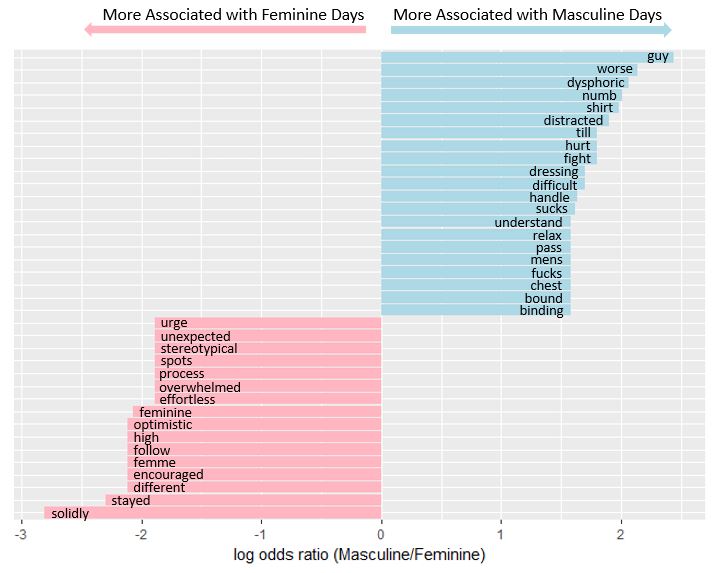
Many of the same words as before, but the ratio gives a better sense of how much more the word was used in the category compared to the other. “Pass” was a standout in the masculine category – it was used both in the “wanting to pass as male” sense as well as wanting the feelings or masculine period to 'pass'. In the feminine category, “effortless” stands out to me. What a perfect way to describe my experience when feeling feminine. I don’t have to try, I just am. Neither of those words would ever be used in the opposite category, since I have no problem “passing” as female and cannot recall any “effortless” masculine swings. Yay for statistics checking out!

Sentiment
So the analysis of my words suggest that that masculine periods are pretty negative and feminine periods are fairly positive (still with some shame and such), but to be sure I did some sentiment analysis.
Sentiment analysis is the process of determining whether a piece of writing is positive, negative, or neutral. It’s related to opinion mining, which is a big thing for marketing departments in companies – they want to know what people think about their brand/product/whatever. You can get pretty involved with sentiment analysis, use part of speech tagging, really try to understand semantics (meaning) or what is being said. Honestly though, I didn’t go too deep for this, I wrote the data so I know what it says. This was more of a fun exercise in sentiment analysis methods.
I wanted to look at the sentiment of my daily thoughts and feelings across each of my gender categories. For this I used the AFINN dictionary a list of English words rated for valence on a -5 (highly negative word) to +5 (highly positive word) scale. I scored each day of text in my data by averaging the AFINN ratings for all the dictionary words the text contained.
Distributions of these daily sentiment scores can be found below, separated by gender category. The average sentiment score is also shown for each gender category.
Sentiment Distributions, by Gender
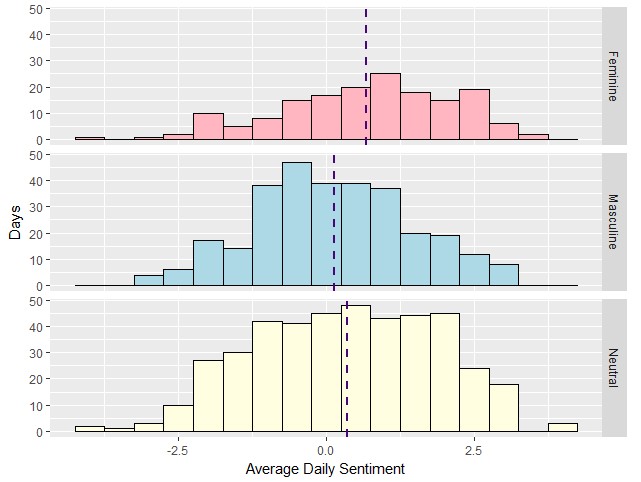
Not huge differences, but the sentiment distribution does seem to skew more positive for feminine days and more negative for masculine days. Well done AFINN! It’s also clear from the distributions how many more days I am neutral compared to masculine and especially feminine. A much more balanced sentiment distribution for neutral category days as well. Which makes sense - typically when I’m neutral, gender just isn’t really on my mind as much. I don’t experience any or much gender dysphoria, I’m usually happy in whatever I’m wearing - generally presenting gender neutral or as a mix of masculine and feminine-assigned clothing. Since it is more socially acceptable for females to dress masculine or androgenous than it is for those clocked as male (BS, I know, I can say soooo much on the devaluation of femininity!) my social anxiety is usually manageable. As a result, not being obsessed about gender on neutral days gives me the freedom to obsess about other things - apparently in a fairly balanced way over time according to the distribution.
So again, this was just a quick exercise, I didn’t dive too deep into the world of sentiment analysis for this since I already knew the answer. There are many imperfections that I didn’t put in the time to address - for example negations (e.g. “not happy” would be characterized as positive as the dictionary would just pick up on “happy”), amplifiers (e.g. “very happy” would just account for the score for “happy” even though it is more extreme), and misspellings (so many...) were not corrected. I expect that the results would be even stronger if I tightened this up.

So What About That “Aha!” ?
 Told you I’d come back!
Told you I’d come back!
So remember back in the gender tracker dashboard, visually we saw more frequent gender fluctuations after mid-April of 2016 - wtf right?!?
I ran some numbers to be sure it was a thing – first up the percentage of “switch days” – those where I moved into a different gender category than I was the previous day (feminine, neutral, or masculine). Before mid- April 26.5% of days were “switch” days, this increased to 35.7% of the days after! In addition, the average number of days I spent in a gender category before switching to a different category decreased from 3.5 before mid-April to 2.8 days after. Something was definitely afoot here.
There indeed was a lot going on mid-April 2016. My partner and I were both graduating from school and getting ready to move to a new state. New places and new jobs are always stressful, but especially with my gender-fueled social anxieties, stress causing more rapid fluctuations could be an explanation. However, the increased fluctuations seem to persist way beyond an adjustment period, they appear to be the new normal?
A more likely explanation was a shift in my thinking taking place after an “Aha!” sort of moment in a therapy session. It was brought to my attention that the distress I feel when masculine is actually less about the actual unhappiness and gender dysphoria and more about the extra shame and judgements I place on myself during that time. It was an identity crisis every single time I would have a masculine swing - because I would have feelings that I strongly felt were against who I was as a person. Being masculine would highlight just how much I care about superficial things like body image, clothes, and appearance. It would reveal transphobic attitudes that I would never impose on someone else, but that were somehow ok to impose on myself. It would show just how much I subscribed to gender stereotypes, roles, and norms when I felt that I should be “better” than that, “above” it. So I would shame and beat myself up about it. And I can be pretty cruel.
This mid-April session also featured a lesson in “radical acceptance”. Which is probably a whole academic thing, but here is how it was explained to me: it’s like you have to accept all the things about you – even if it is a bad or a mean thought you have to let yourself have it. And it turns out that by doing that instead of shaming, repressing, or judging yourself for it, you are better able to change your attitudes to be more in line with who you want to be. So instead of getting angry at myself because I cared what people think or subscribed to stereotypes, I needed to allow myself to have those feelings - because they are normal and human. And in theory by giving permission to have my feelings, I would better be able to challenge myself in a loving way, eventually becoming more secure and true to my beliefs.
It was stupid simple, and definitely stuff I had been told before, but I guess I was finally ready to hear it then. The way it was presented to me sunk in. And it stuck. I truly started adopting this practice of self-acceptance and compassion in a way that I never had before. Which appears to have made a difference according to the data. The distribution of my gender before and after this “aha!” looks noticeably different, especially on the feminine end.
Gender Distribution Before and After "Aha!"
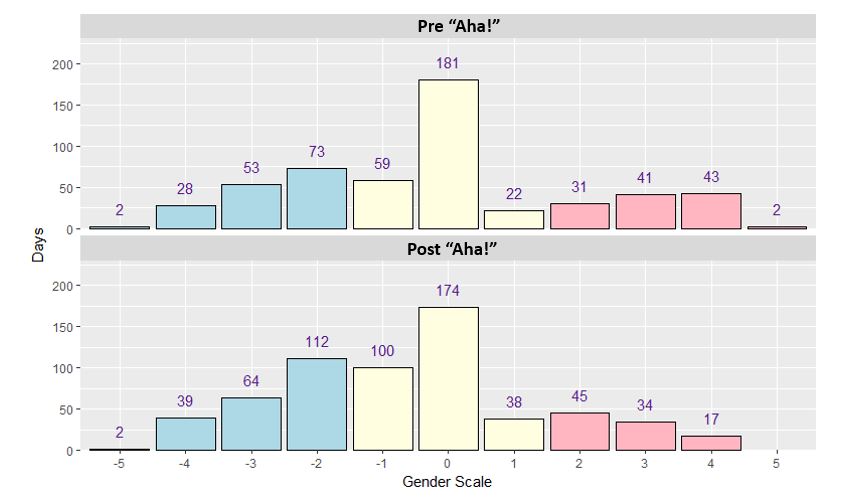
As I mentioned before, at the beginning I would constantly search for “reasons” I was feeling a certain gender, either as a way to feel in control of, shame, or invalidate myself. Related to this, I would often question if I was actually feeling feminine, or if I was “forcing” myself to feel that way. In hindsight, and especially looking at the data, I feel like there was much truth to this. In addition to my personal high, as someone assigned female at birth (afab), presenting feminine gives me the most social benefits – people are nicer to me, I feel safer in public cause I don’t stand out, I don’t feel pressure to “win people over” with my personality (paging social anxiety!) cause I can rely on looking “acceptable” to them. So, I do feel like at the beginning of this, as well as many other periods in my life, I have forced myself to be feminine in order to have the high and feel in control. It was much easier to do this if I bought into stereotypes - I would do things I associated as “girly” (tight clothes, shaving/grooming, dangly earrings, etc) to try to tip myself over the edge.
It appears from the post “aha!” decline on the feminine end of the spectrum that I have tapered down this feminine forcing. This along with the increased amount of gender switches suggest that I might have become more comfortable with my gender identity – I’m letting myself have the swings instead of fighting them. In short, it seems like these radical acceptance people are on to something!
To test if this “aha!” had any effect on my wellbeing, I again turned to sentiment analysis, but this time with a more faceted dictionary. The NRC Emotion Lexicon categorizes words by a variety of different sentiment measures – trust, anger sadness, joy, fear, and more. Radar charts can help us visualize my “emotional shape” before and after the “aha!”
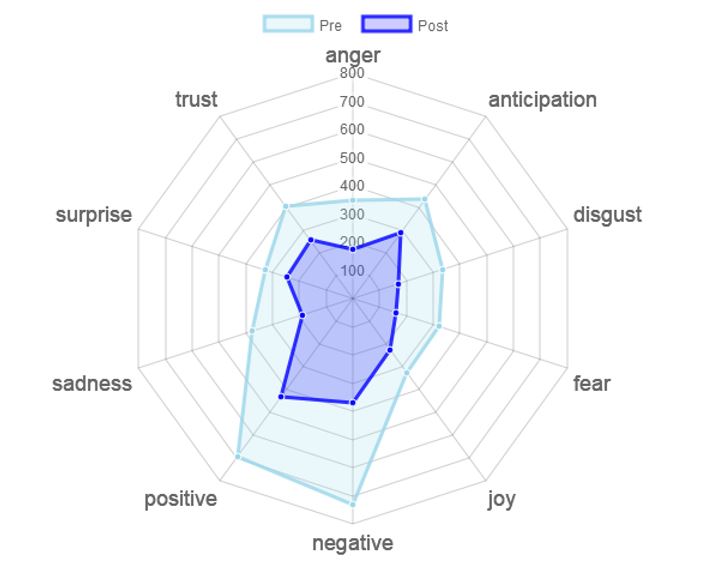
The first thing that is noticeable on the masculine chart is that I had much less writing after the “aha!” – gender was just not on my mind as much as I stopped questioning and judging every motive and feeling I had and just let them happen. We are considering the shapes though in this chart, so the size difference doesn’t really matter.
Looking closely, I can see noticeable indents in the sadness and anger measures. Positive also outweighs negative in the post-“aha!” shape and the surprise measure seems to jut out. It may be a reach, but I’m going to take that as I was constantly surprised that I could be actually be feeling better during masculine periods.
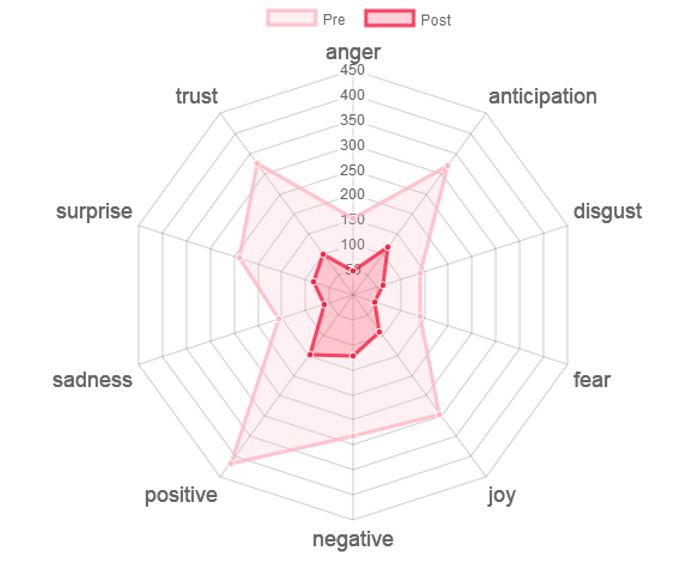
On the feminine end, we can see that the pre-”aha!” shape has a drastically different shape than my pre masculine chart – it juts out at anticipation (makes sense due to “when am I going to lose this feeling?” comments), trust, joy, and positivity.
The post-“aha!” shape is very similar to pre for feminine periods, with the exception of an increase in the negative measure. Which, is actually good. The goal was never to be “high” and happy all the time, but to be balanced, to just be me. When gender is not consuming all my thoughts, at either emotional extreme, I am free to live my life and feel emotions related to other things – which is much better.

What Now?!
My Writing Over Time
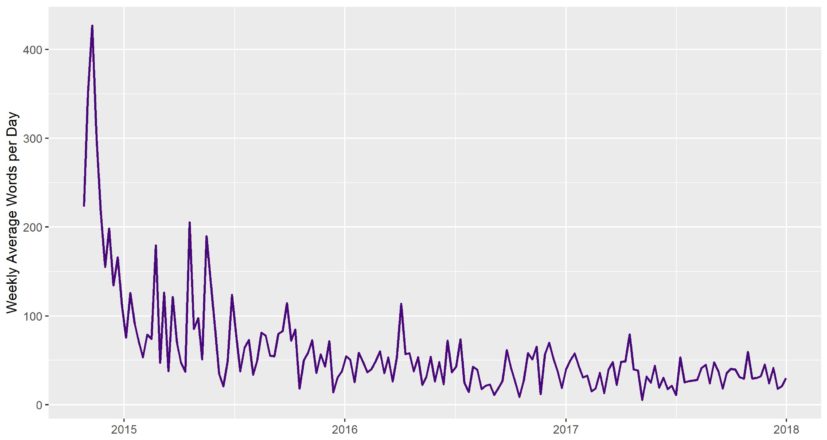
With the reduction in how much gender consumes my life, so did the quality of my data. I would write less, be less diligent in my recording, have more gaps, etc. So I stopped recording going into 2018. I’d love to continue tracking, but I’d rather have no data than bad data. And honestly, now that I’ve gotten to this place of “being ok” and dare-i-say “acceptance”, it seems healthier to stop overanalyzing. It was necessary at the time, it helped me get here, and was kind of in the spirit of radical acceptance the entire time – I had the honesty, just needed to learn the self-love part.
I still experience gender dysphoria and most of the distressing things that the data highlights above, however, without the layer of judgement I can be more level headed about it when it hits. It is still unpleasant, but more manageable now - it doesn’t take over like it used to. And if it does it is ok, I can let myself have the feelings and attitudes and figure out what I need to do to feel better. On the feminine end, I wish I could say the forcing doesn’t happen anymore, but, we live in a gendered society and I’m human. If there is an event or a situation where I feel the need to impress cishet people it’s likely I’ll femme myself up no matter where I am gender-wise. It’s the easier option for me - to not have to deal with the hassle that comes from being “different” in our society. Sometimes I’m just not up for the fight. I do realize this ability is conditional privilege that comes at the expense of my authenticity. I’m working on it.
Major shout outs to the people who had a role in my journey. You know who you are. I can’t express how much gratitude I have for your support, time, insight, and sincerity. The impact on my life is more than you will ever know.
I hope that sharing my journey here will help others on theirs (while sprinkling in a bit of data science!). I know that along the way I found much comfort in reading the narratives and experiences of others who were brave enough to put their story online. I now hope to return the favor. In that spirit, here are a few resources I saved along the way because I found them helpful –
- Genderqueer.me (transgender & non-binary resources)
- Genderfluidity in a relationship
- Sex beyond the binary
- Trans guys guide to menstruation
- Confessions from people who are genderfluid
- 20 things to do for gender dysphoria
- 8 things non-binary people need to know
- Dressing for work while gender nonconforming
- Finding a healthy masculinity
- Non-binary perspective on top surgery
- Brene Brown (buy her books, now. They are amazing)

Data Deets
Code can be pulled from github. Instructions included if you are interested in analyzing your own gender data!
Want MORE?!
Catch a discussion of this piece, and other queer musings, on the always hilarious My Gay Agenda: An Investigative Podcast.


